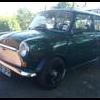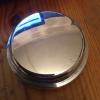Shimming The Diff For Preload.
#1

Posted 13 July 2010 - 03:56 PM
#2

Posted 13 July 2010 - 04:05 PM
Ive done this a few times but mainly on rear diffs for bmws. If i rember rightly you put blue dye on four or so of the crown wheels teeth and then rotate it at least ten times. Then look for the area on the crown wheels teeth where most of the blue is this shows where the point of mesh is. It needs to be in the center, you can move this position by placing shims on eather side.
(now some one will come and explain that better say im wrong and all will be well) have a good day sir
Guess works will know how to explain it good with corect termanologie.
Edited by me madjoe 90, 13 July 2010 - 04:08 PM.
#3

Posted 13 July 2010 - 04:17 PM
#4

Posted 13 July 2010 - 04:18 PM
I will paraphrase the process below but please read through an early Haynes to confirm the basics and the actual desired preload figure.
Loosen both diff side covers.
Loosen the nuts securing the removable part of the diff housing to the gearbox casing.
Remove the side covers. The diff should be "movable" (left to right) if you push/pull on its outputs.
Fit a new gasket to the right-hand side cover and torque the side cover in place. The diff should still be free to move left/right.
PUSH the differential HARD to the right. It needs to hit the right-hand side cover.
Fit the left-hand side cover to the gearbox WITHOUT shims and without a gasket. Tighten its bolts a little... but do not torque them. The side cover should be in contact with bearing.
Using feeler gauges, measure the gap between the side cover and gearbox. Measure as many places as you can get the feeler gauges into, then average the numbers.
Now take it all apart again.
Measure the compressed thickness of the gasket you used on the right-hand side cover. Use this value along with feeler gauge measurements to determine how many shims are needed
to achieve the specified preload.
Any tables in Haynes will be based on the compressed gasket thicknesses common during the 1960s. As I mentioned earlier, the new gaskets are much thicker. Therefore... be sure to use the compressed gasket thickness you measured... not the value in Haynes.
This all may sound "unclear" until you attempt it on the bench.
#5

Posted 13 July 2010 - 04:24 PM
This is how i do it,Hi. Just finnished my gearbox build and about to embark on the engine next. Anyway before I put the gearbox away for a while, the preload on the diff has been bothering me. I simply stuck the shims that came out of the diff side cover back in and tightened everything up. Job done. Or is it? how do I check the preload is correct. Looked through the haynes manual, nothing, searched TMF, ( diff shims ) and trawled through 12 pages of stuff before i got bored. Is this something I should worry about or will the old shims be ok. Please help as im old now and cant afford to loose this much sleep.
turn gearbox so diff is uppermost,fit diff pushing to clutch side(non shimmed side),fit diff casing/housing and lightly tighten bolts/nuts,fit clutch side diff plate with gasket,torque to 18lb/ft,make sure you dont bottom these bolts out as 2 are longer for exhaust bracket,if you dont have one put 2 washers under heads on uppermost bolts.
fit other side plate with no gaskets or shims,nip bolts then release them enough to locate the plate.
push the plate against bearing and measure gap between casing and sideplate,note this gap.
measure gasket you are using,allowing .05mm when compressed.
The gap between sideplate and diff casing needs to be 0.025 to .05mm greater than gaskets compressed width for the preload needed.
if you have to much movement in diff side to side you will get excessive torquesteer.
example,gasket measures 0.38mm minus the 0.05mm compressed you need a gap 0.35 to 0.38mm.
Rover recommends a preload of .025mm to .05mm,always aim to get close to the lower reading.
use various shims to get the required preload.
hth
dave
Edited by Dave33, 13 July 2010 - 04:27 PM.
#6

Posted 13 July 2010 - 04:28 PM
Edited by AndyMiniMad., 13 July 2010 - 04:29 PM.
#7

Posted 13 July 2010 - 08:37 PM
#8

Posted 13 July 2010 - 09:48 PM
If you have thrust & radial bearings then all is ok, however if you have the latest style of diff bearing then they won't last 5 minutes if you apply a thrust or a preload to them
Exhaust mounting bracket could be 1 of 3 different types, you could have a single bolt, a double bolt or a triple bolt type and these use the 5/16"unc x 1 1/8"long machine screws, all others are 1" long
#9

Posted 13 July 2010 - 10:43 PM
Have only known 3 types of bearing for the diff,This all depends on the type of bearing being used.............
If you have thrust & radial bearings then all is ok, however if you have the latest style of diff bearing then they won't last 5 minutes if you apply a thrust or a preload to them
Exhaust mounting bracket could be 1 of 3 different types, you could have a single bolt, a double bolt or a triple bolt type and these use the 5/16"unc x 1 1/8"long machine screws, all others are 1" long
One type that needs fitting one way round(has THRUST stampped on it).
One that can be fitted either way(latest type),
Early non thrust type that required 1-2thou preload
Maybe a bit more info would help Andy identify if he has a bearing that requires no preload?
Edited by Dave33, 13 July 2010 - 11:51 PM.
1 user(s) are reading this topic
0 members, 1 guests, 0 anonymous users
















